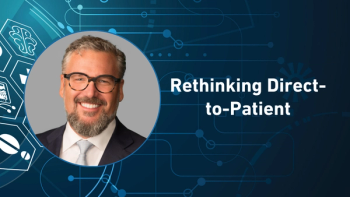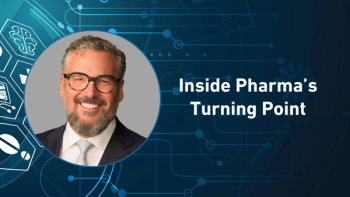
Shaping Strategies for a New Era of Engagement and Commercialization
With the business model changing and the patent cliff looming, Ashfield Engage's Chris Savage talks about what these upheavals mean for pharma companies, their sales reps, and their patients
With the pharma business model changing and the looming patent cliff putting billions of dollars in sales at risk, Pharma Commerce speaks to Chris Savage, SVP of global strategy and North American sales and marketing at Ashfield Engage, about what these upheavals mean for pharma companies, their sales reps, and their patients.
Pharma Commerce: Can you outline your day-to-day role? What are your strategic aims?
Chris Savage: I'm focused on the overall strategy for our organization. That includes driving our evolution from a contract sales organization (CSO)-based service provider to a strategic engagement and commercialization partner that engages with providers, patients, payers, and life sciences companies to impact treatment outcomes positively. I partner with our specialist area leaders to identify industry trends, understand their impact on our customers, and design solutions that will meet our customer needs and drive them to evolve their customer engagement approaches.
In North America, I’m also involved in driving our sales and marketing efforts. Our Ashfield Engage business unit has transformed considerably over the last five years. We have moved from a commercial sales outsourcing business to a full-service engagement partner offering scientific, educational, and promotional engagements to payers, providers, and in the US, patients.
Are any of your customers discussing concerns around products coming off-patent?
The portfolio of each of our partner companies is unique, so while all companies will face loss of exclusivity at some point, ultimately, I don’t believe it’s necessarily a bad thing as loss of exclusivity spurs innovation and reduces overall healthcare costs. For example, if we look back 10 years, primary care medicine spending accounted for ~74% of spend on medications in the top 10 developed countries, according to IQVIA, driven by large primary care brands including Lipitor, Plavix, and Nexium. As those brands reached and passed maturity, life sciences companies have evolved their focus, moving towards more targeted therapies which have addressed many previous un or undertreated diseases. Now as we look at drug spending, specialty medications account for nearly half, and in the next four years, the expectation is that that percentage will continue to grow, nearing 60% in the top 10 developed countries.
Do you think the patent cliff will stifle innovation or foster it?
Undoubtedly, it will foster innovation. Ultimately, pharma companies are driven to create life-saving and life-altering medications and, as a byproduct, generate shareholder value. We’ve already seen an evolution within the life sciences industry from primary care to specialty medications and we’re now seeing the next evolution as we move from specialty/biologics into cell and gene therapy. While there is significant scientific evolution required to make cell and gene therapies a core staple of the industry, what intrigues me most about this next evolution in how we define value and monetize these therapies. To date, much of medicine spending has been at the point of administration, such as when a patient picks up a prescription from a pharmacy or a product is administered in the HCP’s office. As we move to more curative therapies, determining price and more importantly, who pays, especially in markets like the US, will be interesting to watch since a million-dollar treatment in Year 1 may prevent years of maintenance therapy and/or future acute hospital care.
What are the implications for their sales and commercial teams? What’s the current thinking around managing these scenarios?
For all life sciences companies, I believe the biggest implication of this changing landscape is how you effectively deploy resources to ensure HCPs, payers, and patients have the right information at the right time to make an informed prescribing decision. In scenarios where an HCP may only see one or a few patients with a given condition in a year, it’s not feasible from a cost or customer experience perspective to have a sales rep in the office on a weekly basis repeating a core set of messages. Instead, life sciences companies need to find a way to leverage digital and remote engagements to drive awareness and familiarity with products and then deploy human resources (MSLs, sales reps, or service personnel) at the right time to address specific needs. More importantly, though, this deployment model can’t be standard across all HCPs; instead, the model must be deployed individually, based on the needs of each HCP and her patient population. The ability to turn on/turn off resources intelligently in local geographies will be an interesting challenge for life sciences companies. For companies with a larger portfolio of products, there will likely be continued value in having some level of internalized selling resources. But for companies with smaller portfolios, there will likely be a need to re-evaluate the mix of internal and outsourced resources to maximize efficiency.
The challenges above are exacerbated for commercial biotech startups, which have to manage how they invest their capital before their product starts generating revenue. It takes a tremendous amount of effort and time to commercialize a product and focusing internal resources on driving that regulatory milestone is critical.
One of the challenges many of these companies face is finding the right balance of how much they invest pre- versus post-launch and how much they invest internally vs through an outsourced provider as well as the implications of those decisions. From my experience launching products, I believe there are five key beliefs an HCP must have to prescribe a product:
- Belief in the disease state
- Belief in the market opportunity analysis of the product offering
- Belief in the company itself
- Belief that the product is the most clinically effective choice for the patient
- Belief that the patient can get the medicine once it's been prescribed
The first three beliefs can be established through scientific, PR engagements, and congress presence prior to approval, but are often delayed to manage expenses. Unfortunately, since belief building is done somewhat sequentially, this can cause delays in launch uptake and create a need for increased expenditure post-launch to recover from a poor launch uptake.
Ultimately, we recommend that commercialization planning starts at least 24 to 36 months before launch, with a focus on architecting an ideal treatment experience, identifying the moments that matter for all stakeholders, and then developing an understanding of the key stakeholders in delivering that experience. At that point, then it becomes a question of how best to deliver those experiences and which parts should be internalized versus outsourced.
Conversely, what challenges are generic and biosimilar developers coming to you with?
For biosimilar providers, the biggest question is how to differentiate themselves. Because of the dynamics of the biosimilar market (i.e., formulary tier status, interchangeability), there is a need to compete and win on more than just price. And it's important to note that biosimilar manufacturers have to compete not only with other biosimilar providers but also with the reference drug maker as well. If we think about the beliefs mentioned above, the area where a biosimilar company can truly differentiate itself is through patient access. Securing reimbursement, ensuring adequate supply, and a robust patient experience are key focuses. In the US market, we’re about to see this play out in real-time with biosimilars being launched in 2023 for Humira, a $21B drug in 2021. Watching how early launchers establish price and service levels will provide a view on the future of biosimilars and will push those companies with later launch dates to further innovate their engagement offerings to capture share
As we see more new, more personalized products entering the market, how will sales and commercial teams need to adapt?
The key to engagement is to ensure that the right message is delivered in the right channel to the right stakeholder at the right time to drive the right actions that improve patient outcomes. How a life sciences company informs all of those decisions must be based on high-quality, well-synthesized data. But that decision on what message or what channel can’t be made just once, prior to the launch of a product. Instead, it must be constantly revisited and adjusted as we monitor when, how, and why stakeholders interact with the life sciences company. And it must be at a personalized level. For some stakeholders, a total digital engagement footprint is best. For others, an entirely human-based engagement footprint will drive the best response. For others a mix. And for many, the footprint may change based on where a product is in its lifecycle and where the stakeholder is in her adoption process.
Given the complexity of these engagement models, the biggest adaption for marketing and sales teams will be to increase agility. For marketing teams, it’s imperative to think about the creation of agile teams comprised of data analysts, marketers, agency resources, and med/legal/regulatory resources who can quickly generate insights, and develop, approve, and deploy multiple variations of content that will resonate with different stakeholder profiles. For sales/engagement teams, this agility will come in the form of turning on and off engagement channels with stakeholders based on their evolving persona. This may include staffing up or down based on engagement volume, changing the type of resource from educational to sales and back, or evolving the footprint/territory an individual must cover.
Newsletter
Stay ahead in the life sciences industry with Pharmaceutical Commerce, the latest news, trends, and strategies in drug distribution, commercialization, and market access.




